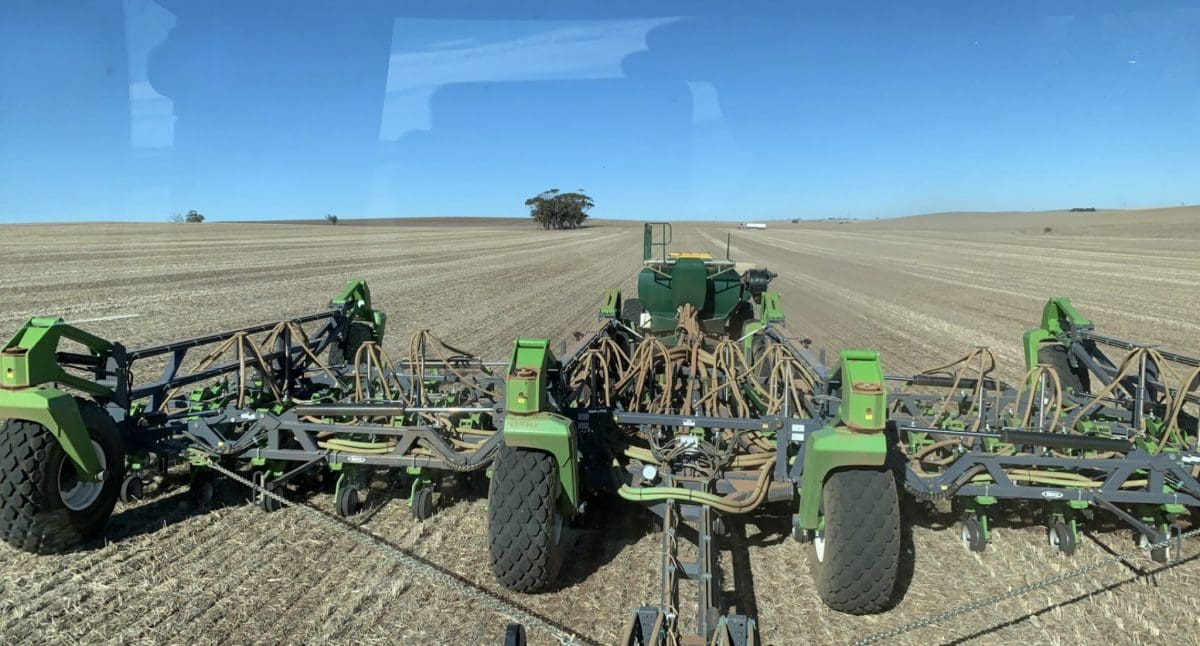
Barley is dry sown on the weekend in South Australia’s Mid North ahead of rain which fell on Monday and Tuesday. Photo: Luke Simon
CROPPING country in South Australia and western Victoria got rain from Monday night and into yesterday which will be enough to germinate most dry-sown cereals, pulses and canola, and enable further seeding.
Registrations mostly totalled 8-25 millimetres, and follow-up falls are needed to cement potential for average or better yields in the face of limited subsoil moisture in paddocks stretching from the Upper Eyre Peninsula in SA to the Victorian Mallee.
AGRIvision general manager Ed Nixon said he estimated around 80 per cent of the Mallee’s winter crop had been sown dry ahead of the rain.
Mr Nixon said field peas, barley and later wheats would finish off most growers’ planting programs for this year.
“A few late lentil paddocks are going in on the back of strengthening pricing,” Mr Nixon said.
Mr Nixon said this week’s rain has not brought a break to the season and the soaking growers were hoping for, but average or better yields were still well and truly possible.
He said the dry preceding months have prevented growers from getting on top of weeds ahead of sowing, and weeds would require careful management in coming weeks to help maximise yield potential.
“Without any summer or autumn rain, weeds haven’t germinated, and there’ll be pressure on growers to deal with those all at once.”
However, he said diversity of plantings was helpful.
“People spread their risk with different types of crop and varieties.”
Mr Nixon described germination as “patchy at best” towards the Wimmera in districts including Charlton, Donald and Warracknabeal.
“In the Wimmera, they got a bit more rain over summer than the Mallee did, and they’ve got some moisture profile in patches.”
At Clare in SA’s Mid North, Ground Up Agronomy principal Michelle Bammann said plenty of dry sowing had occurred ahead of this rain.
“The main concern at the moment is that if everything comes up at the same time, a hot north wind in spring or a frost can really knock around the crop.”
However, Ms Bammann said the outlook for winter rainfall was promising, and moisture under the crop going into spring would be helpful.
“They’re still talking a wet June and July.”
Hay area drops
China’s reduced appetite for Australian hay, coupled with strong prices for canola, have had the biggest impact on planting intentions for SA and Victorian growers.
“Growers have swapped out oats for hay this year, and put a vetch over some self-sown barley for sheep feed,” Ms Bammann said.
At Jamestown in SA’s Upper North, NR Ag agronomist Mark Smallacombe said around 10mm had fallen at Jamestown, with more to the south and less to the north.
“It’s well received but we need more, and no crops are out of the ground yet,” Mr Smallacombe said
Mr Smallacombe said there was a big variation in how much growers in the Upper North had seeded.
“Some have a good number of paddocks in, and some growers have nothing in, and if you’ve sown it all now, it’s all going to be on the same frost radar.
“That could be a worry.”
Late canola possible
Mr Smallacombe said hay crops, which were down on area on last year, plus legumes and canola had largely been sown to date.
“The canola situation is interesting; ideally we like to sow on moisture by May 10, but with the price of it being so good, most of it has been sown dry.
“Sowing canola from Anzac Day to May 10 gives it the best opportunity, even if it’s not a huge spring, for an above-average yield.
“Ideally, you’d like to get your crops in in May, but you can still grow good crops if you sow in June.
“It really depends on the spring.
“Wheat and barley will be the last to go in.
In the SA Mallee, Pinnaroo grower and Crop Smart agronomist Aaron Oakley said growers were expected to finish planting in the next fortnight.
“It’s getting late enough but it’s not too late; in 2016, it didn’t rain until well into June and we still had a really good year.”
“I think a fair few growers have stuck to their programs and sown dry, but there may be a bit of canola taken out because it didn’t rain earlier.
“The one thing that has come out of the rotation is export hay; that’s definitely scaled back.
“There’s probably some wheat and barley and some oats going in instead.”
At Lock on SA’s Eyre Peninsula (EP), Lock Ag Services agronomist Fergus Slape said on average around 20mm had fallen in the district.
“There’s a bit of everything in the ground, but mostly faba beans and lentils, and a lot of the canola,” Mr Slape said.
Field peas and wheat are expected to finish the Upper EP programs, and Mr Slape said some barley paddocks have already been sown too.
“Some people sow canola first, and others will wait until it rains; some canola is up on the lighter soil types.”
“This rain should be enough to get all the crop up where people got the 20mm.”
Registrations in the week to 9am today in Victoria included: Nhill 8mm; Ouyen 6mm; St Arnaud 17mm; Swan Hill 5mm, and 10mm at Horsham and Warracknabeal.
In SA, falls included: Bordertown 15mm; Clare 2mm; Crystal Brook 18mm; Lock 16mm; Paskeville 23mm; Pinnaroo 1mm, and Wudinna 14mm.
Grain Central: Get our free cropping news straight to your inbox – Click here



HAVE YOUR SAY